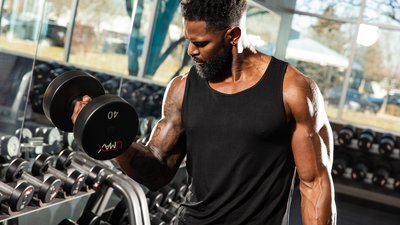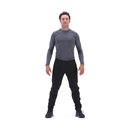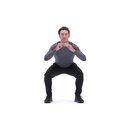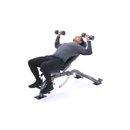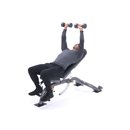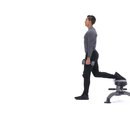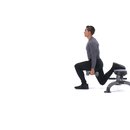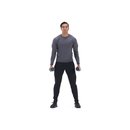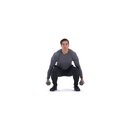Everyone has to start somewhere. Even the fittest of the fit had to walk into a gym a little wet behind the biceps. Fortunately, you've already put your best foot forward by educating yourself before you start training. When it comes to building muscle, losing weight, and getting fit, it's far easier to go wrong than it is to blindly stumble onto the right formula.
When you're a total novice, the best thing you can do is ease into training. If you strain so hard that the veins in your forehead read like a roadmap, the next day you'll feel stiffer than the Tin Man after a dip in the Pacific. Yes, it's only natural and expected to experience a little post-workout pain, but you shouldn't be bumping up the share price of your favourite ibuprofen. This is not the route you have to take.
The following is the most basic muscle-building plan for the everyman. If you have any injuries, see a professional to figure out whether you can do these moves. You should expect to feel comfortable with all of these exercises. Some trainers may argue that these are advanced exercises and that novices should use machines first. However, these exercises involve essential, everyday actions (performed with a weight) that even a 5-year-old can do with a smile.
If you can't perform these exercises, see a medical professional about fixing your imbalances before you start any kind of exercise program. If you have a persistent, irresolvable injury, simply leave out the exercises you can't do and replace them with the nearest machine equivalent that your gym has to offer.
In less than four weeks you'll probably have to fork out some money for a few new shirts. It's a small price to pay for sleeve-splitting arms and a more muscular frame.
Getting Started
Perform the following workouts 2-4 times per week and perform a different workout each day. You don't need to do the workouts on the days of the week listed here—these are included just as an illustration—but make sure to either do them two days in a row with a rest day afterward, or alternate between rest and training days. Rest for 60-90 seconds between each set.
Figure out during the first two weeks what weights you're capable of pushing. After this, try to increase the weights by 3-7 percent each week. In a few short weeks you'll be the proud owner of a newly refurbished body made of box-fresh muscle.
Beginner's Total Muscle-Building Program

BodyFit
$6.99/month- 2,500+ expert-created single workouts
- 3,500+ how-to exercise videos
- Detailed workout instruction
- Step-by-step workout tips
- Training at gym or at home
- Access to Workout Plans
- Access to Bodyfit App
- Store Discounts
Already have a Bodybuilding.com account with BodyFit? Sign In

What comes with BodyFit?

- Instructional Videos
Don't risk doing a workout improperly! Avoid injury and keep your form in check with in-depth instructional videos.

- How-to Images
View our enormous library of workout photos and see exactly how each exercise should be done before you give it a shot.

- Step-by-Step Instructions
Quickly read through our step-by-step directions to ensure you're doing each workout correctly the first time, every time.

BodyFit
$6.99/month- 2,500+ expert-created single workouts
- 3,500+ how-to exercise videos
- Detailed workout instruction
- Step-by-step workout tips
- Training at gym or at home
- Access to Workout Plans
- Access to Bodyfit App
- Store Discounts
Already have a Bodybuilding.com account with BodyFit? Sign In

What comes with BodyFit?

- Instructional Videos
Don't risk doing a workout improperly! Avoid injury and keep your form in check with in-depth instructional videos.

- How-to Images
View our enormous library of workout photos and see exactly how each exercise should be done before you give it a shot.

- Step-by-Step Instructions
Quickly read through our step-by-step directions to ensure you're doing each workout correctly the first time, every time.

BodyFit
$6.99/month- 2,500+ expert-created single workouts
- 3,500+ how-to exercise videos
- Detailed workout instruction
- Step-by-step workout tips
- Training at gym or at home
- Access to Workout Plans
- Access to Bodyfit App
- Store Discounts
Already have a Bodybuilding.com account with BodyFit? Sign In

What comes with BodyFit?

- Instructional Videos
Don't risk doing a workout improperly! Avoid injury and keep your form in check with in-depth instructional videos.

- How-to Images
View our enormous library of workout photos and see exactly how each exercise should be done before you give it a shot.

- Step-by-Step Instructions
Quickly read through our step-by-step directions to ensure you're doing each workout correctly the first time, every time.

BodyFit
$6.99/month- 2,500+ expert-created single workouts
- 3,500+ how-to exercise videos
- Detailed workout instruction
- Step-by-step workout tips
- Training at gym or at home
- Access to Workout Plans
- Access to Bodyfit App
- Store Discounts
Already have a Bodybuilding.com account with BodyFit? Sign In

What comes with BodyFit?

- Instructional Videos
Don't risk doing a workout improperly! Avoid injury and keep your form in check with in-depth instructional videos.

- How-to Images
View our enormous library of workout photos and see exactly how each exercise should be done before you give it a shot.

- Step-by-Step Instructions
Quickly read through our step-by-step directions to ensure you're doing each workout correctly the first time, every time.
Progressing the Program
Phase 1 (Weeks 1-8): Stick with the program for approximately two months. However, if you have a little experience and your growth and fitness progression become stagnant, move to Phase 2. Try to increase the weights by 2-7 percent each week. If you initially do bodyweight exercises, progress to doing weighted versions of those exercises in order to continually challenge yourself.
Phase 2 (Weeks 8-12): Do 12 reps instead of 15. Increase the weights from Phase 1 by 10-15 percent and keep resting for a maximum of 60 seconds between sets.
Phase 3 (Weeks 12-18): Do 10 reps instead of 12. Do 4 sets instead of 3 and rest for 45 seconds between sets. Increase the weights from Phase 2 by 10-15 percent.
Finished? Well done. You're officially a weightlifter.
Q&A With Ray Klerk
When, in your opinion, did you become a weightlifter? Was there a book like "Body Trainer for Men" that played a part?
I first walked into a gym at the age of 18, but I wish there was a "Body Trainer for Men" out there, because that would mean time travel was possible and I could rectify all the things I got so horrifically wrong. Fortunately, a good friend Juan Houzet who was, and still is, a muscled man-beast guided my early efforts on the baby-weights. He had experience and we trained together, but after a while our schedules didn't match up so I began the journey on my own.
At first this was difficult because it's never clear how to set yourself a challenge when you are your own nemesis. It's almost a line drawn in the sand. It slaps you in the face, dares you. As that skinny kid, when I found the iron asylum, I knew I'd crossed that line. Feeling its cold touch, I somehow knew we'd never be apart. Though I was at the bottom of the food chain, when I looked up I knew I belonged.
Sadly, most of my earliest missteps were actually nutritional, and had I known then what I know now ... I can only imagine what kind of gains I would have made. So I hope people can learn from my mistakes and don't strictly look to the web, because getting information from the Internet can be like drinking from a fire hydrant.
What would you do differently if you could do it all again?
My old diet was so bad I still feel like I should be paying penance by flagellating myself with organically grown asparagus. I'd feast on Marmite and white bread sandwiches after training with no protein at all—yep, that's about as smart as playing leapfrog with a unicorn. Since my post-workout nutrition was totally counterproductive, my rate of muscle gain was set at a glacial pace, even though I trained religiously. Plus, I stuck to the same program and always trained the same body parts together on the same days.
If I had that time machine, I'd have stuck with full-body routines; they deliver far superior results. And I'd throw a handful of protein powder directly into my eyes with a self-punch to the kidneys for good measure.
When someone embarks on a beginning weight-training program, is it more important to target dietary blind spots (alcohol, sugar, or what have you), or to squeeze in greater amounts of healthy foods?
Healthy bodies build more muscle, because they can keep at it in the long term. If you're getting sick or have a weakened immune system, then you're going to lose a huge portion of your gains the first time you get sick.
In terms of the dietary blind spots, I wouldn't recommend changing too much to start with, because this can make you want to stop eating and exercising. Rather, do everything gradually. Start training. Increase your protein intake before and after your workouts. Then try to slowly improve your overall diet as you get more keen on the results you see.
Tell someone their favorite foods shouldn't be massaging their taste buds if they start an exercise program and you'll doom them to failure. One step at a time is important for success.
Who did you have in mind when you wrote this program? Break down the logic for that man.
It's aimed at blokes who are aged 20-50 with a variety of experience in training and working out. Even if your exercise routine consists of living in a three-story house and forgetting things on the top floor, there is something for everyone in the book. The reader will be able to clearly identify which stage they are at in life and what their goals should be. There is also enough variety in the programs and chapters for readers to progress to once they complete a chosen program or achieve a certain objective.
In terms of the logic, most programs stress training certain body parts on certain days, but I've found life to be far too intrusive to handcuff yourself to workouts weeks in advance. A birthday party here, fishing trip there, then a few late nights in the office or pub, and you're playing catch-up. As such, I've always believed that people should do full-body programs. That way, if you miss a workout, no body part suffers as a result and you can simply do it the following week.
Training a particular body part in a workout does have its place, but I found that it's best to alternate between this approach and the full-body approach. Plus, the full-body routines leave you perspiring like a sausage dog in a Vietnamese restaurant, and there's something soulfully satisfying about sweating yourself silly.
Many men looking to get fit start by throwing themselves into running or stationary cycling for extended periods of time, or they start with bodyweight moves only. Why start with weights instead?
Let me first state that weights are not for everyone. Yes, we should all be doing weights, and heaven knows there is enough science to support that notion, but it doesn't have to be weights. You can lift a few boulders on the beach, toss the kids in the air (your own hopefully), or go rock climbing—whatever forces your muscles out of their comfort zone is good.
These activities—as well as weightlifting—challenge your muscles and strengthen your entire body, which acts like an insurance policy for your mobility for when you get older. So, whether you're 24 or 64, you should be trying to get stronger, because we're subject to the law of "use it or lose it." Weights help you build muscle and strength in a low-risk environment, whereas bodyweight stuff can be too difficult for most people who aren't fit.
Try getting a guy who is a regular at the drive-thru to do a push-up on his knees. He'll do four reps while shaking like a constipated Chihuahua, feel deflated, and may stop exercising because he can't do the most basic bodyweight exercise, which probably reminds him of his failures in school gym class. But get that same guy under a bench press and he'll get a tremendous sense of accomplishment, which will have him coming back for more.
Obviously, from a technical standpoint, more muscle means a bigger calorie burn in whatever you do, and weights deliver this far better than cardio ever can. Plus, sitting on a stationary bike or treadmill is about as boring as watching cardboard exist, so it's no wonder people lose motivation.
If someone has seen too many "CrossFit Fail" YouTube videos and is scared of barbell cleans, what regression would you recommend?
I'd try a combination of exercises: the upright row with a dumbbell in each hand, and then add some deadlifts and barbell shrugs into your routine. You'll soon be ready for big cleans.
You don't have any body part split workouts in your book until the advanced plans, favoring full-body workouts instead. Are splits overused? Are they even necessary?
Splits are a great way to take a break from your full-body routine. If you do a split for two months and return to your full-body workouts, you'll watch yourself add huge amounts of muscle. Time and time again, science (listed in my book) has suggested that full-body workouts which last less than an hour improve your hormonal profile, which leads to greater gains. It's time-effective and delivers far superior results for the average guy.
But if you're after a bigger peak to your biceps or more striations in your chest, then go for the bodybuilding routine. But even that kind of thinking is flawed, because you respond in a limited capacity to localized muscle-building. Yes, it works to a degree, but doing big lifts in every workout will build your entire body in the correct proportions. I've even found research that got guys to do deadlifts or biceps curls for a month and the deadlifters came away with bigger arms. That's all the vilification I needed to stop getting bogged down with the details, and by that I mean the isolation exercises and days where biceps are the only muscle worked.
It's my opinion that most people enjoy building their muscles and just want to look good in their latest selfie. Only a small part of the population feels the need to stand on a stage in a luminescent codpiece and pop a double biceps pose. Yet people with no bodybuilding ambitions are still doing bodybuilder routines, so that's why I always stick to recommending full-body routines. When you bust ass on them, you get serious results.


